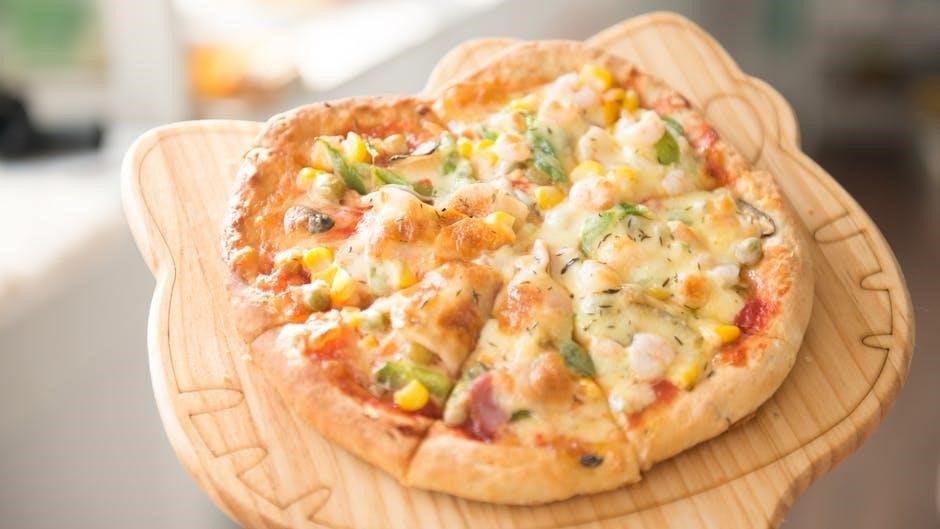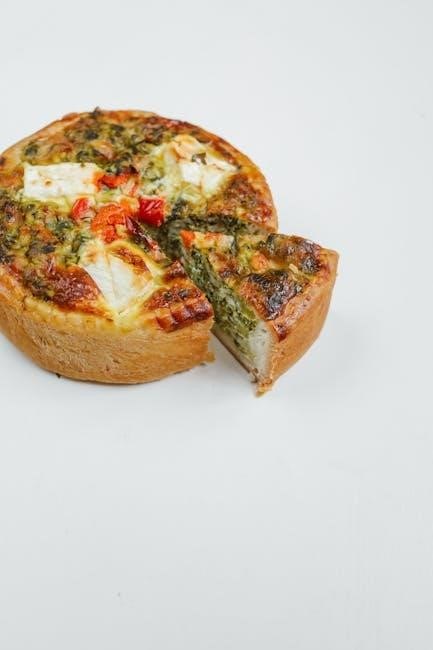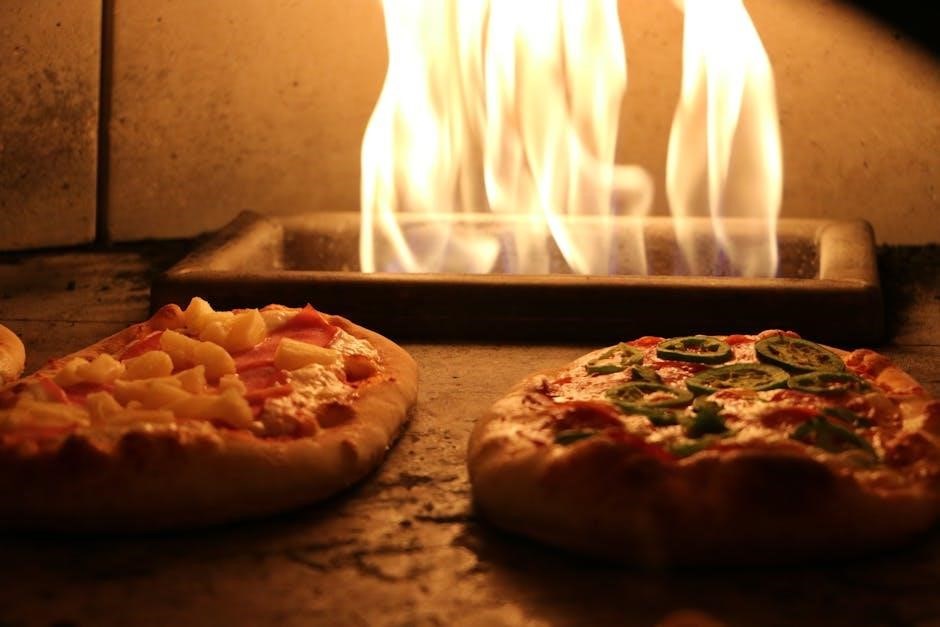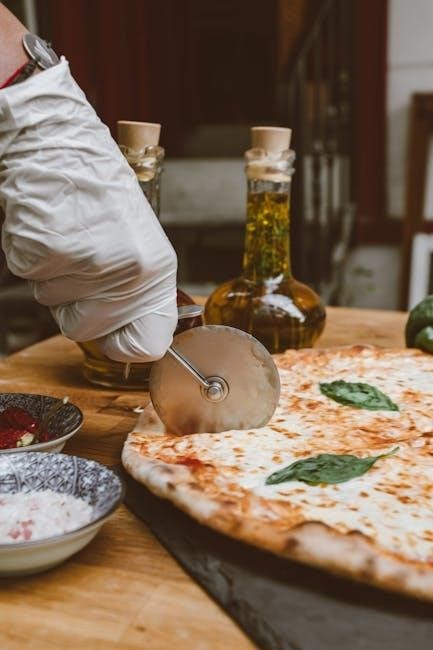
Cooking a DiGiorno Rising Crust Pizza is a straightforward process that yields a delicious, restaurant-quality meal at home. The pizza bakes at 400°F for 22-25 minutes, resulting in a golden-brown crust and perfectly melted cheese.
Preheating the Oven
Preheating the oven is a crucial step when cooking a DiGiorno Rising Crust Pizza. The oven should be preheated to 400°F (200°C) to ensure the pizza cooks evenly and the crust rises properly. It’s important to keep the pizza frozen while the oven is preheating to prevent it from thawing prematurely. Once the oven has reached the desired temperature, it’s ready for baking. Some users recommend placing a pizza stone in the oven during preheating to enhance crust crispiness, but this is optional. Always ensure the oven is fully preheated before placing the pizza inside, as this step is essential for achieving the perfect golden-brown crust and melted cheese. Proper preheating helps the pizza cook consistently and prevents undercooked or overcooked areas.

Preparing the Pizza for Baking
Before baking, remove the DiGiorno Rising Crust Pizza from the freezer and take it out of the freshness wrap. Place the pizza on a flat surface, such as a cutting board or pizza pan, to prepare it for the oven. Some users recommend placing the pizza on a cookie sheet lined with parchment paper to prevent the crust from becoming too crispy. Others suggest sliding a metal spatula under the pizza to ensure it can be easily transferred to the oven rack. Keep the pizza frozen until it’s ready to bake, as thawing it prematurely can affect the rising crust. Once preheated, carefully place the pizza directly on the center oven rack or on a prepared pan. Always use oven mitts or utensils to handle the pizza to avoid direct contact with hot surfaces. Proper preparation ensures the pizza bakes evenly and safely.

Baking the Pizza
Bake the DiGiorno Rising Crust Pizza at 400°F for 22-25 minutes. The pizza is done when the edges are golden and the cheese is melted and slightly bubbly. Use oven mitts or utensils to handle the pizza safely.
Recommended Temperature
The recommended temperature for baking a DiGiorno Rising Crust Pizza is 400°F (200°C). This temperature ensures the crust rises properly and the cheese melts evenly. Preheat your oven to this setting while keeping the pizza frozen. Once preheated, place the pizza directly on the center rack or a cookie sheet for optimal results. The 400°F temperature is crucial for achieving a golden-brown crust and a well-cooked base. Avoid lowering the temperature, as it may result in an undercooked crust or uneven melting. For a softer crust, bake on a cookie sheet; for a crisper crust, bake directly on the oven rack. Always follow the package instructions for precise temperature guidelines to ensure the best outcome.
Baking Time
The baking time for a DiGiorno Rising Crust Pizza typically ranges between 19 to 27 minutes at 400°F. For a softer crust, bake for 19-23 minutes, while a crisper crust requires 23-27 minutes. The pizza is done when the edges are golden brown, and the cheese is melted and slightly browned. To ensure even cooking, place the pizza directly on the center oven rack or use a cookie sheet. Avoid overbaking, as this can make the crust hard. If baking two pizzas, they can be cooked simultaneously, but check for doneness after 20 minutes. Let the pizza stand for 5 minutes before slicing to allow the cheese to set. Adjust baking time based on personal preference for crust texture, but always follow the package instructions for the best results. Proper baking time ensures a perfectly cooked pizza with a delicious, golden-brown crust and melted cheese.
Checking for Doneness
To determine if your DiGiorno Rising Crust Pizza is fully cooked, look for visual and auditory cues. The crust edges should be golden brown, and the cheese should be melted and slightly browned. Avoid opening the oven too frequently, as this can disrupt the cooking process. Instead, check through the oven window. When the pizza is done, you may hear a slight crackling sound from the crust. Carefully remove the pizza from the oven using oven mitts and a spatula. Gently tap the crust; it should sound hollow, indicating it is fully cooked. If unsure, slide a spatula under the pizza to check the bottom crust for even browning. Proper doneness ensures a crispy crust and evenly melted cheese, making your pizza ready to enjoy after letting it stand for a few minutes.

Handling the Pizza After Baking

After baking, remove the pizza with oven mitts and a spatula. Let it stand for 5 minutes to allow the cheese to set and crust to retain crispiness, ensuring clean slicing.
Letting the Pizza Stand
After baking, it’s crucial to let the pizza stand for 5 minutes before slicing. This step allows the cheese to set and prevents it from oozing out excessively. Use oven mitts to carefully remove the pizza from the oven and place it on a heat-resistant surface. Slide the pizza onto a cutting board or pizza pan using a spatula to avoid direct contact with the hot surface. Letting it stand ensures the crust retains its crispiness and the toppings distribute evenly. Neglecting this step can result in a messy, cheese-drenched pizza that’s difficult to slice neatly. Patience here enhances both the texture and presentation of your DiGiorno Rising Crust Pizza, making it a more enjoyable dining experience.
Slicing the Pizza
Slicing the pizza is the final step before serving. Use a pizza cutter or a sharp knife to ensure clean, even cuts. Place the pizza on a stable, heat-resistant surface and carefully slice through the crust and toppings. For uniform portions, cut the pizza into 4-8 slices, depending on serving size preferences. To avoid accidents, handle the pizza with oven mitts or a trivet, as it may still be hot. Slicing too aggressively can cause toppings to shift, so gentle, steady strokes are recommended. Even distribution of toppings ensures each slice is flavorful. Proper slicing enhances both the presentation and enjoyment of your DiGiorno Rising Crust Pizza, making mealtime more satisfying for everyone.
Tips for Achieving the Perfect Crust
For a perfect crust, bake on a pizza pan or cookie sheet to prevent excessive crispiness. Let the pizza stand for 5 minutes after baking to ensure the cheese sets evenly and the crust retains its texture.

Using a Pizza Pan or Cookie Sheet
Using a pizza pan or cookie sheet can help achieve a softer crust and prevent excessive crispiness. Place the pizza on the pan before baking to ensure even cooking and better texture. This method also makes it easier to handle the pizza after baking, reducing the risk of damage to the crust. Many users recommend this approach to avoid the crust becoming too hard, especially when following the recommended baking time. Additionally, using a pan allows for better control when sliding the pizza out of the oven, making the process safer and more convenient. This simple step can enhance the overall quality of your DiGiorno Rising Crust Pizza, ensuring a delicious and evenly cooked meal every time.
Adjusting Baking Time
Adjusting the baking time is crucial for achieving the perfect crust texture. The recommended baking time for a DiGiorno Rising Crust Pizza is between 22 to 27 minutes at 400°F. However, some users find that baking for 19 to 23 minutes results in a softer crust, while others prefer the full 25 minutes for a crisper texture. It’s important to monitor the pizza during the last few minutes, as oven variations can affect cooking time. If you prefer a less crispy crust, consider reducing the baking time slightly. Conversely, for a golden-brown and firmer crust, bake toward the higher end of the time range. Always check for visual cues, such as melted cheese and a lightly browned crust, to ensure the pizza is cooked to your liking. Adjusting the baking time based on personal preference ensures a perfectly cooked pizza every time.
Using Oven Mitts
Using oven mitts is essential for safely handling a hot DiGiorno Rising Crust Pizza. When removing the pizza from the oven, wear oven mitts to protect your hands from burns. Hold a pizza pan or cookie sheet level and place it near the oven shelf. With your other hand, carefully slide a metal spatula under the pizza to transfer it onto the pan. This method ensures safe and efficient handling. Always prioritize safety by using oven mitts, as direct contact with the hot pizza or oven rack can cause serious injury. Proper use of oven mitts not only protects you but also prevents accidental drops or spills. By following this step, you can enjoy your perfectly baked pizza without any mishaps.

Safety Precautions
Always use oven mitts or utensils to handle the hot pizza and avoid direct contact. Keep children away from the oven while baking to prevent accidents and ensure a safe cooking experience.
Using oven mitts is essential for safely handling a hot DiGiorno Rising Crust Pizza. When removing the pizza from the oven, always wear oven mitts to protect your hands from burns. Hold a pizza pan or cookie sheet with mitts in one hand and use a metal spatula in the other to carefully slide the pizza onto the pan. This method prevents direct contact with the scorching hot pizza and oven rack. Ensure the mitts cover your hands completely and avoid touching any hot surfaces. Proper use of oven mitts ensures a safe and smooth transfer of the pizza, allowing it to cool slightly before slicing. This step is crucial for maintaining safety and preventing accidents while handling the freshly baked pizza.
Using Utensils
Using the right utensils is crucial when cooking a DiGiorno Rising Crust Pizza to ensure safety and ease. A metal spatula is highly recommended for sliding the pizza onto a pan after baking, as it provides the necessary leverage and protection. Place the pizza on a pizza pan or cookie sheet to allow it to cool slightly before slicing. Avoid using plastic utensils, as they may melt or scratch the pizza. Always handle the pizza with care, as it will be extremely hot when removed from the oven. Using proper utensils helps prevent accidents and ensures the pizza is transferred safely. This step is vital for maintaining the integrity of the crust and cheese while handling the pizza post-baking.
Avoiding Direct Contact
Avoiding direct contact with the pizza after baking is essential for safety and to prevent burns. Always use oven mitts or tongs to handle the pizza, as it will be extremely hot. Never touch the pizza crust or cheese directly with your hands, as this can cause severe burns. Instead, use a metal spatula to carefully slide the pizza onto a cutting board or serving plate. Allow the pizza to stand for a few minutes before slicing to let the cheese set and cool slightly. Direct contact can also damage the crust or cause the cheese to stretch unevenly. By avoiding direct contact, you ensure a safe and enjoyable experience while handling the pizza. This step is crucial for maintaining both personal safety and the quality of the pizza.
Common Mistakes to Avoid
Common mistakes include overbaking, using incorrect temperatures, and not letting the pizza stand after baking. These errors can lead to a hard crust, uneven cheese melting, and a less enjoyable experience;
Overbaking
Overbaking is a common mistake that can result in a hard, crispy crust and dry toppings. DiGiorno Rising Crust Pizza should be baked at 400°F for 22-25 minutes. Exceeding this time can cause the crust to become overly browned and rigid. To avoid this, keep an eye on the pizza during the last few minutes of baking. Look for the edges to turn golden brown and the cheese to melt evenly. If the crust starts to darken too quickly, remove the pizza from the oven immediately. Using a timer and checking the pizza periodically ensures it doesn’t overcook. Some users recommend baking for 19-23 minutes for a softer crust. Remember, the pizza will continue to cook slightly after removal, so err on the side of underbaking if unsure. Proper monitoring prevents a burnt, inedible crust and ensures a delicious, perfectly cooked pizza.
Incorrect Temperature
Baking a DiGiorno Rising Crust Pizza at the wrong temperature can lead to poor results. The recommended temperature is 400°F, as specified on the packaging and by users. Baking at a lower temperature may result in a softer, undercooked crust, while a higher temperature can cause the crust to burn before the cheese is fully melted. Some users have reported issues with the crust being too hard when baked at 400°F, suggesting that slight adjustments might be necessary based on personal preference. To ensure the best outcome, preheat the oven to the correct temperature and avoid opening the oven door too often, as this can cause temperature fluctuations. If you prefer a softer crust, consider reducing the temperature slightly or baking for a shorter time. Monitoring the pizza’s progress during baking is key to achieving the perfect balance of crispiness and flavor. Always refer to the instructions for guidance, but feel free to adjust based on your oven’s performance and your desired crust texture.
Not Letting the Pizza Stand
Not letting the pizza stand after baking is a common mistake that can lead to a less-than-perfect result. According to the instructions and user experiences, it’s important to allow the pizza to stand for 5 minutes before slicing. This allows the cheese to set and the crust to retain its crispiness. Skipping this step can result in a soggy crust and cheese that stretches unevenly when sliced. Some users have noted that letting the pizza stand off the pan helps prevent the bottom from becoming soft. By giving the pizza a few minutes to cool slightly, you ensure a better texture and easier slicing. This simple step is crucial for achieving the perfect balance of a crispy crust and melted, even cheese distribution. Always prioritize this step to enjoy your DiGiorno pizza at its best.
Variations in Cooking Instructions
While traditional oven baking is standard, some users opt for alternative methods. Cooking in an air fryer at 375°F for 10-12 minutes yields a crispy crust. Microwaving is quicker but may soften the crust.
Cooking in an Air Fryer
Cooking a DiGiorno Rising Crust Pizza in an air fryer offers a crispy crust and even cooking. Preheat the air fryer to 375°F (190°C) for 2-3 minutes. Place the pizza directly in the air fryer basket, ensuring it fits without overlapping. Cook for 10-12 minutes, or until the crust is golden brown and the cheese is melted and bubbly. Shake the basket halfway through cooking to ensure even browning. Note that the crust may become crisper than oven-baked versions. Let the pizza stand for 2-3 minutes before slicing. This method is ideal for smaller portions or when an oven is unavailable. Results may vary based on the air fryer model, so adjust time and temperature as needed for optimal results.
- Temperature: 375°F (190°C)
- Cooking Time: 10-12 minutes
- Benefits: Crispy crust, even cooking
Cooking in a Microwave
Cooking a DiGiorno Rising Crust Pizza in a microwave is possible but not recommended, as it may result in uneven cooking and a softer crust. If using a microwave, follow these steps: Place the pizza on a microwave-safe plate or dish. Cook on high for 3-4 minutes, depending on your microwave’s power level. Check the pizza after 3 minutes; if the cheese is melted and the crust is golden, it’s done. If not, cook in 30-second increments until desired doneness. Note that the crust may not rise as well as in an oven, and the texture may differ. For best results, use a lower power level (30-45%) to prevent overheating. Let the pizza stand for 1-2 minutes before slicing. While convenient, microwave cooking may not achieve the same quality as oven baking.
- Power Level: 30-45%
- Cooking Time: 3-4 minutes
- Result: Softer crust, uneven cooking
Pro Tip: Rotate the pizza halfway through cooking for even heating.

Troubleshooting Common Issues
If the crust doesn’t rise properly, ensure the oven is preheated correctly and the pizza isn’t thawed. For uneven cheese melting, rotate the pizza midway. Avoid overbaking to prevent a hard crust.
Pro Tip: Check the pizza frequently during the last few minutes of baking.
Crust Not Rising Properly
If the crust isn’t rising as expected, it may be due to incorrect oven temperature or improper placement. Ensure the oven is preheated to 400°F and the pizza is placed directly on the center rack. Avoid thawing the pizza beforehand, as this can hinder the rising process. If using a cookie sheet, lightly grease it to prevent the crust from sticking. Another common issue is opening the oven too early, which can cause the crust to collapse. Let the pizza bake undisturbed for at least 15 minutes before checking. If the crust still doesn’t rise, try rotating the pizza halfway through baking to ensure even heat distribution. For optimal results, follow the recommended baking time of 22-25 minutes and let the pizza stand for 5 minutes after baking to allow the crust to set properly.
Pro Tip: Use a pizza pan for better air circulation.
Cheese Not Melting Evenly
If the cheese isn’t melting evenly, it could be due to uneven heat distribution in the oven or improper placement of the pizza. To resolve this, ensure the oven is preheated to the correct temperature (400°F) and the pizza is placed on the center rack for consistent heat. Avoid opening the oven door too frequently, as this can cause temperature fluctuations. If using a cookie sheet or pizza pan, make sure it’s lightly greased to promote even melting. Another tip is to rotate the pizza halfway through the baking time to ensure the cheese melts uniformly. For optimal results, bake for the recommended 22-25 minutes. If the cheese still isn’t melting evenly, try increasing the oven temperature slightly, but be cautious not to overbake the crust. Letting the pizza stand for 5 minutes after baking also helps the cheese set properly and evenly.
Pro Tip: Use a pizza pan for better heat circulation.
Nutrition and Ingredients
A DiGiorno Rising Crust Pizza is made with high-quality ingredients, including enriched wheat flour, water, yeast, and a blend of cheeses like mozzarella, parmesan, and asiago. The rising crust is designed to create a light and airy texture, while the sauce is made from vine-ripened tomatoes. Toppings vary depending on the flavor but often include meats like pepperoni, sausage, and bacon, as well as vegetables like onions and bell peppers. Each serving (1/5 of the pizza) typically contains around 300-400 calories, with varying amounts of fat, sodium, and protein. The pizza is a convenient and flavorful meal option, though it should be consumed in moderation as part of a balanced diet. Always check the packaging for specific nutritional information, as ingredients and values may vary by product.
Tip: For a healthier option, consider adding fresh vegetables or reducing cheese for a lighter version.

Cooking a DiGiorno Rising Crust Pizza is a simple and satisfying process that delivers a delicious, homemade-style meal. By following the instructions to preheat your oven to 400°F, bake for 22-25 minutes, and let the pizza stand for 5 minutes after baking, you can achieve a perfectly cooked crust and evenly melted cheese. Tips like using a pizza pan or cookie sheet can enhance the texture, while safety precautions ensure a hassle-free experience. Avoid common mistakes like overbaking or incorrect temperatures to get the best results. With its convenient cooking process and high-quality ingredients, a DiGiorno Rising Crust Pizza is an excellent choice for a quick and tasty meal. Enjoy your perfectly baked pizza with family and friends!

Leave a Reply
You must be logged in to post a comment.